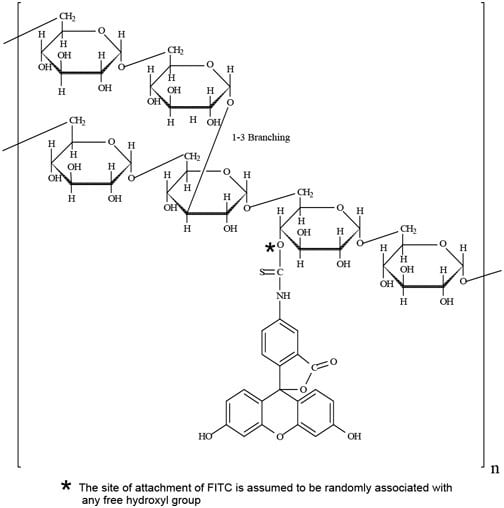Fluorescein Isothiocyanate-Dextran
SYNONYM: FITC-Dextran
Structure
Dextran is a polymer of anhydroglucose. It is composed of approximately 95% alpha-D-(166) linkages. The remaining (163) linkages account for the branching of dextran.1,2,3 Conflicting data on the branch lengths implies that the average branch length is less than three glucose units.4,5 However, other methods indicate branches of greater than 50 glucose units exist.6,7 Native dextran has been found to have a molecular weight (MW) in the range of 9 million to 500 million.8,9,10 Lower MW dextrans will exhibit slightly less branching4 and have a more narrow range of MW distribution.11 Dextrans with MW greater than 10,000 behave as if they are highly branched. As the MW increases, dextran molecules attain greater symmetry.7,12,13 Dextrans with MW of 2,000 to 10,000, exhibit the properties of an expandable coil.12 At MW below 2,000, dextran is more rod-like.14 The MW of dextran is measured by one or more of the following methods: low angle laser light scattering,15 size exclusion chromatography,16 copper-complexation17 and anthrone reagent18 colorometric reducing-end sugar determination and viscosity.12

Physical Properties
The approximate Stokes' radii for FITC-dextrans are as follows;11
FITC is conjugated randomly to hydroxyl groups of dextran at a frequency of 0.003 to 0.02 moles of FITC per mole of glucose.
Fluorescent Properties
The excitation maximum of FITC-dextran is 490 nm. The emission maximum is 520 nm.11 The fluorescence increases with pH and is optimal at pH 8 and above.11
Method of Preparation
Our dextrans are derived from Leuconostoc mesenteroides, strain B 512. Various MW are produced by limited hydrolysis and fractionation. Our supplier's exact methods are held proprietary. Fractionation can be accomplished by size exclusion chromatography16 or ethanol fractionation, where the largest MW dextrans precipitate first.19 The FITC conjugation with hydroxyl groups of dextran is carried out in DMSO.20
Storage/Stability
Stored properly at 2-8 °C and protected from light FITC-dextran powders should be stable for a minimum of two to three years.
Solubility/Solution Stability
We typically test the solubility of FITC dextrans in water at concentrations at or above 25 mg/ml. Solutions should be protected from light. In vivo, FITC-dextran is stable for more than 24 hours.21
Applications
FITC-dextran is used extensively in microcirculation and cell permeability research utilizing microfluorimetry.22,23 FITC-dextran has been used to study plant cell wall porosity24 and capillary permeability.25,26 Plasma proteins have been shown not to bind to FITC-dextran.26
Related Products
References
如要继续阅读,请登录或创建帐户。
暂无帐户?